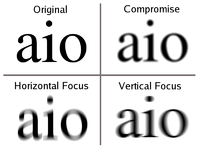
Photo from wikipedia
PurposeTo evaluate the corneal topographic changes and postvitrectomy astigmatism after 27-gauge (g) microincision vitrectomy surgery (MIVS) by using Pentacam HR-Scheimpflug imaging system.MethodsThis prospective descriptive study included 30 eyes of 30… Click to show full abstract
PurposeTo evaluate the corneal topographic changes and postvitrectomy astigmatism after 27-gauge (g) microincision vitrectomy surgery (MIVS) by using Pentacam HR-Scheimpflug imaging system.MethodsThis prospective descriptive study included 30 eyes of 30 patients who underwent 27-g MIVS. All eyes underwent a Pentacam HR examination preoperatively and on the first week, first month and third month postoperatively. The power of the corneal astigmatism, mean keratometry (Km), K1 and K2 values and corneal asphericity (Q value) values for the both front and back surfaces of the cornea, index of surface variance (ISV), index of vertical asymmetry (IVA), index of height asymmetry (IHA), index of height decentration (IHD) and higher-order aberrations including coma, trefoil, spherical aberration, higher-order root-mean-square and total RMS were recorded. Additionally, the mean induced astigmatism was estimated by vector analysis.ResultsNo statistically significant changes were observed in the mean power of corneal astigmatism, mean keratometry, K1 and K2 values, corneal asphericity values, ISV, IVA, IHA, IHD and higher-order aberrations on the first week, first month and third month after the operation. The mean surgically induced astigmatism was calculated as 0.23 ± 0.11 D on the first week, 0.19 ± 0.10 D on the first month and 0.19 ± 0.08 D on the third month postoperatively.ConclusionMinor corneal surface and induced astigmatic changes are expected to result in rapid visual rehabilitation after pars plana vitrectomy with the 27-g MIVS system.
Journal Title: International Ophthalmology
Year Published: 2017
Link to full text (if available)
Share on Social Media: Sign Up to like & get
recommendations!